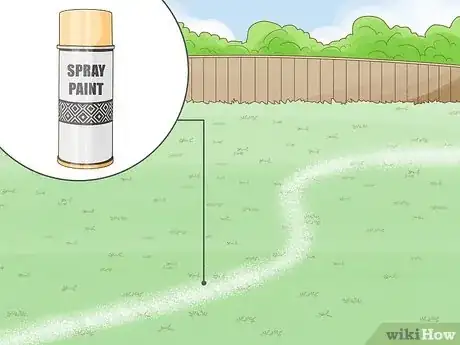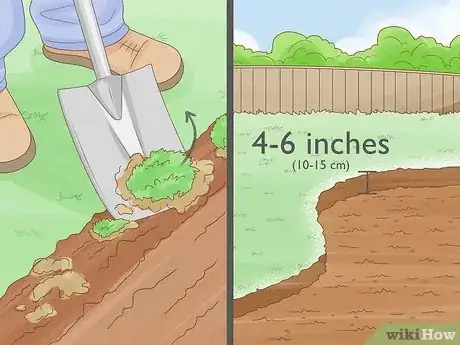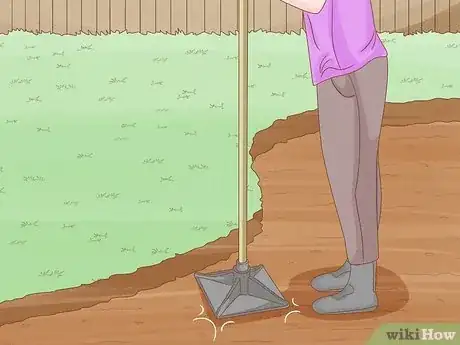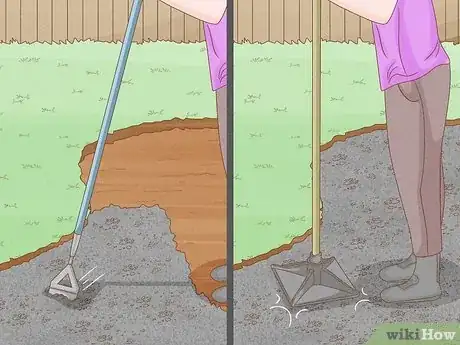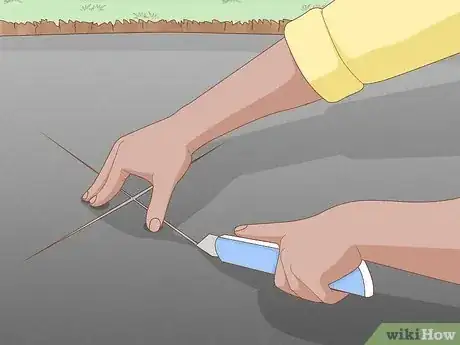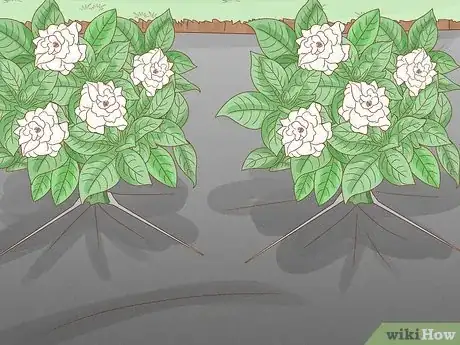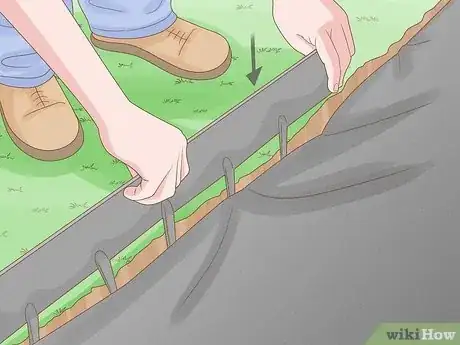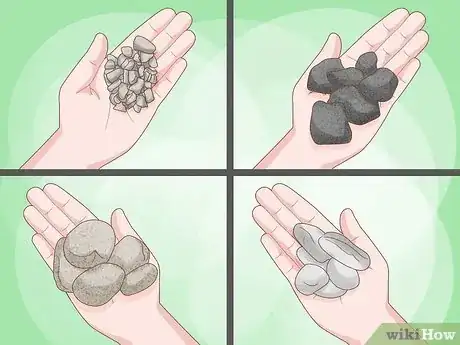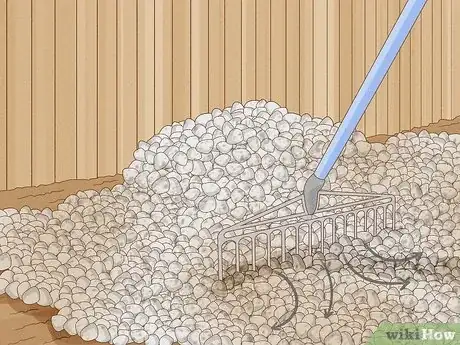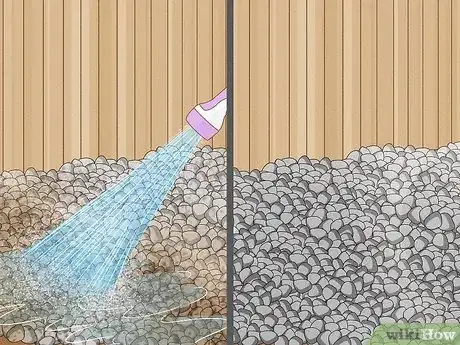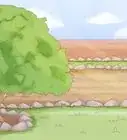This article was co-authored by Matt Daly and by wikiHow staff writer, Eric McClure. Matt Daly is a Landscape Designer and the Founder of Water & Earth Landscape Design, which is based in both Richmond, Virginia, and San Jose, California. With nearly 10 years of experience, he specializes in designing outdoor living spaces, including patios, pools, and fireplaces. Matt also runs a blog where he educates homeowners about landscaping topics: https://www.liveinyourbackyard.com/. He earned his Landscape Design & Horticulture Certification from The University of Richmond, where he also studied Sustainable Landscape Practices.
This article has been viewed 18,065 times.
Looking to give your garden or yard a fresh look? Trying to save some time on future yard maintenance? If so, landscape rock is perfect for you! Laying landscape rock isn’t particularly difficult, and this is definitely the kind of project you could complete in a few hours if you buy your materials ahead of time. In this article, we’ll walk you through everything you need to know about installing new stones in your yard.
Steps
Site Preparation
-
1Mark the area where you want to lay landscaping rocks. Grab a can of spray paint and outline the area that you’re going to fill in with landscaping rocks. If you don’t want to permanently mark the ground, you can lay out landscape edging or a hose to outline the area. This will make it easier to track where you need to dig and give you a sense for how many rocks you’ll need to buy.[1]
- If you’re laying the rocks in a rectangular shape, measure the square footage. Landscape rocks often list the square footage they’ll cover on the label.
- If you don’t measure the square footage or the shape you’re filling isn’t symmetrical, rely on your eye to estimate how many rocks you’ll need. It’s okay to have some left over! The rocks tend to go missing over time.
- Do this during a dry spell when the soil will be loose and easy to remove.
-
2Dig the topsoil out of the area you marked. If there’s already a space for the landscaping rocks, you don’t need to dig anything out so long as you pull any weeds out. Otherwise, grab a shovel and get to digging! You can use a tiller instead if you happen to own one. Remove all vegetation with a hoe, shovel, or rake. Only dig to the depth you plan to fill.[2]
- For gravel or any other kind of rock that would easily fit in your palm, dig 4–6 inches (10–15 cm) deep.
- If you plan on using larger rocks with a little bit of heft to them, dig 6–8 inches (15–20 cm) deep.
- If you’re excavating a large amount of soil, set a tarp next to you before you start. Empty the soil out on to the tarp as you work. This way, you can slide the tarp along the ground to make the soil easier to remove when you’re done.
Advertisement -
3Tamp the exposed soil down to compact it. Once you’ve excavated the area, grab a tampering tool and repeatedly slam the flat plate at the bottom against the soil. This will keep the soil from coming loose when the heavy rocks shift in tumultuous weather, which will help the area maintain its shape and depth.[3]
- If you have a roller designed for leveling floors, you can use that instead.
- If you really want to beat the soil down and compact it, use a motorized compactor.
-
4Pour and tamp crushed stone on top of the soil if you’ll walk on it. Purchase some finely-crushed stone and pour it into the area you’ve excavated. Spread the stone out with a rake to make it even and tamp it down with a tampering tool or compactor the same way you tamped the soil. This will create a more stable walkway and help your stones stay in place over time.[4]
- Skip the crushed stone if you plan on adding any plants, since root systems tend to struggle in stone.
- If these rocks are decorative and you’re not using them to lay a walkway, you can totally skip the crushed stone. Its main benefit is that it stabilizes the rocks but if you aren’t walking on them, there’s no need.
Landscape Fabric, Plants, and Edging
-
1Spread landscape fabric over the area you’ve excavated. Purchase a roll of landscaping fabric. Unravel it over the area you dug out and cut it off of the roll using scissors. If necessary, cut multiple sheets out and overlap them as needed to totally cover the soil (or crushed stone). This will help prevent weeds from pushing through the rocks over time.[5]
- If you don’t want to use landscape fabric, at least lay newspaper down to snuff out any existing seeds or hidden weeds.
-
2Cut an X-shape anywhere you want to place plants. Adding plants is optional, but you can totally grow a few plants in a plot filled with landscaping rocks. If you plan on adding plants, grab some scissors or a utility knife and cut an X-shape into the landscape fabric everywhere you’re adding a plant. This will give you some working room to dig soil out and place your plants.[6]
- Keep in mind, it will be very difficult for your plants to get water since the surrounding soil won’t be getting much water (if any).
- Your best bet here are hardy perennials that are drought-resistant. Cacti, yarrow, and hardy bushes should all be okay depending on your climate.
- Avoid planting any especially fragile plants that require a lot of sun and nutrients. Ferns, most flowers, and palms won’t do well, for example.
-
3Place your plants in the soil where you cut your Xs. Use a trowel or shovel to dig out enough soil for you to place your plants and set them in the soil. What you do next depends on the type of plant you’re going to grow, so follow the care instructions specific to your plant species. You’ll likely need to fill in soil around the base of the plant and water thoroughly.[7]
- Seeds usually won’t have enough space to grow with all the rocks on top, so use mature plants for this.
-
4Install landscape edging if you want a raised or decorative edge. Use a shovel or a trowel to dig out a small trench along the rim of the area you’ve excavated. Slide the landscape fabric away before you dig each section out, then pull it back over each section of the trench once it’s dug out. When you’re done digging, use a rubber mallet to gently tap the edging into place.[8]
- The edging should also keep your landscape fabric in place over time.
- Edging isn’t mandatory, but it can look quite nice! On top of that, the edging will help keep the rocks contained—especially if you’re using something small, like pea gravel.
Landscape Rocks
-
1Choose a landscaping rock and buy enough to fill the area in. Select a rock that will look good in your yard or garden. Lighter rocks will deflect sun, while darker rocks will absorb it if you want to shift the temperature in your garden a bit. Beyond that, the option is totally up to you! Here are some options:[9]
- River rock. These smooth, durable stones are a mix of gray, tan, and white. They have a coastal vibe, and look great in the rain.
- Gravel. Gravel is a natural stone that comes in a variety of colors and sizes. It also tends to be cheap, which is great if you need a lot of it.
- Lava rock. These rocks come in a variety of colors, and they’re able to reduce weed growth if you’re worried about that specifically.
- Marble rock. These bright stones look exceptionally elegant, but they do cost a pretty penny.
-
2Pour your rocks over the landscape fabric and spread them out. Walk around the area you excavated as you empty out each bag of stones. Fill in roughly 4–8 inches (10–20 cm) until the rocks are roughly level with the surrounding soil. If you want a bigger, bolder look, you can even make the rock pile taller than the area around it so it stands out! Use a rake to spread the stones out to your liking.[10]
- If the ground isn’t even, start at the bottom of the slope. This way, the stones won’t roll all over the place and disrupt the fabric and soil underneath.
- Hold on to any extra rocks! Animals, crazy weather, and walking on the stones can compact them or cause them to go missing.
-
3Rinse the rocks to remove the dust. Grab a hose and spray down the rocks. This will remove that rock dust from the stones and help them settle in place. Now you can enjoy your new yard or garden!
- Beyond the occasional rinse whenever the stones get dusty and a light raking to keep the stones in the area, you shouldn’t need to do any maintenance.[11]
Things You’ll Need
- Spray paint, hose, or edging
- Shovel
- Hoe (optional)
- Trowel
- Landscape fabric
- Scissors
- Crushed stone (optional)
- Rake
- Landscape rock
References
- ↑ https://www.bobvila.com/articles/how-to-make-a-gravel-driveway/
- ↑ https://www.gardenista.com/posts/hardscaping-101-pea-gravel/
- ↑ https://www.lawnstarter.com/blog/landscaping/how-to-landscape-with-pea-gravel/
- ↑ https://www.thisoldhouse.com/sidewalks/21016412/how-to-lay-a-budget-friendly-gravel-path
- ↑ https://www.gardenista.com/posts/hardscaping-101-pea-gravel/
- ↑ https://www.baltimoresun.com/news/bs-xpm-1992-05-17-1992138131-story.html
- ↑ https://www.baltimoresun.com/news/bs-xpm-1992-05-17-1992138131-story.html
- ↑ https://www.thisoldhouse.com/sidewalks/21016412/how-to-lay-a-budget-friendly-gravel-path
- ↑ https://www.homestratosphere.com/types-of-landscaping-rocks/
